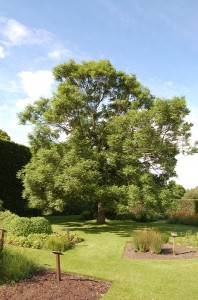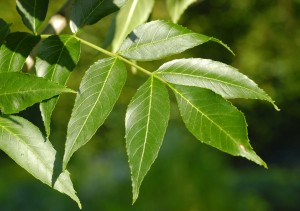Ash – Fraxinus excelsior (Oleaceae)
Gaelic: uinnseann
Ash is native to most of Europe, and is one of the commonest large trees in Scottish woodlands, growing 25-30m in height. The Common Ash can be distinguished from other species by the black leaf buds which are present during the winter. The leaves are compound and comprise of 7-13 leaflets. Ash is wind pollinated and can either have male and female flowers on the same tree, but in separate clusters (monoecious), Male and female flowers on separate trees (dioecious) or male and female flowers occurring together (bisexual). The fruit is winged and are known as ‘ash keys’.
The wood is widely used, and has been an important resource in the past. The wood is flexible and shock resistant and so has traditionally been used for the making of bows, tool handles, hockey sticks and police truncheons. Ash wood is also used for the making of Hurleys, the sticks used in the Irish game Hurling.
There is a strong mythology attached to the ash stemming from Norse mythology where the World Tree, Yggdrasil is an ash. It is seen as the centre of the world. Its roots are anchored in the underworld and watered by the streams of wisdom and faith, the trunk is supported by the earth and the crown touches the arc of heaven. The legendary strength of the ash tree led to a tradition in the Scottish highlands of midwives giving sap from the ash to new born babies, as it was believed this would give them the strength of the ash and protect it from evil spells.
Recently ash populations in Great Britain have been threatened by the arrival of ‘ash dieback’, a disease caused by the fungus Chalara fraxinea. This disease causes leaf loss and crown dieback in those trees infected and eventually leads to the death of most of those infected. This new disease has the potential to dramatically change woodlands across Britain and affect the wildlife which is supported by ash.
You can read more on Ash Dieback and the work being done at RBGE here:
http://stories.rbge.org.uk/archives/2051
http://stories.rbge.org.uk/archives/2760
http://stories.rbge.org.uk/archives/3325
http://stories.rbge.org.uk/archives/3843
http://stories.rbge.org.uk/archives/4013



2 Comments
2 Pingbacks